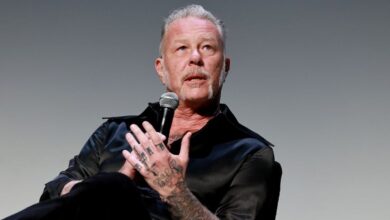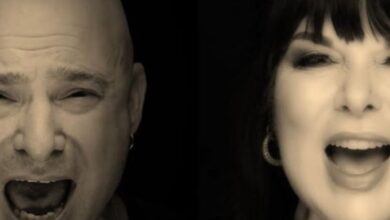Any Given Day Transform Rihanna’s “Diamonds” Into a Metal Masterpiece
Any Given Day’s metal take on Rihanna’s “Diamonds” became one of those rare crossover moments where a pop anthem was reborn as a thundering metalcore statement. The performance-driven video raced around the internet, pulling in millions of views and introducing the German group to listeners far outside the scene’s usual boundaries. Years later, it still circulates widely, cited by fans as an example of how a great pop melody can survive—and even thrive—inside a heavier framework.
The band behind the cover formed in 2012 in Gelsenkirchen, Germany, blending melodic metalcore with a taste for big hooks and dramatic dynamics. The early lineup featured vocalist Dennis Diehl, guitarists Andy Posdziech and Dennis ter Schmitten, bassist Michael Golinski, and drummer Raphael Altmann; Leon Stiller would take over on drums later. That stable core let them refine a sound equally comfortable with snarling riffs and sing-along refrains.
Context matters for why this particular cover connected. Rihanna’s “Diamonds” launched in 2012 as a global hit, so the song’s melody and phrasing were already etched into mainstream memory. Any Given Day first put their version on YouTube in the early years of the band, and demand never really faded; in December 2022 they finally issued an anniversary version on streaming platforms to mark a decade since it first took off online.
Part of the appeal lies in the arrangement, which pivots between glassy clean passages and serrated, down-tuned surges. Diehl’s ability to alternate chesty, radio-ready choruses with forceful growls gives the track a cinematic width—soft-loud arcs that mirror the lyric’s shift from vulnerability to resolve. The band’s label notes his dual-role approach as a hallmark of their identity, and it’s on full display here.
Rhythmically, the cover leans into modern metalcore punch: tight kick patterns, emphatic snare accents, and palm-muted guitar figures that open into ringing chords when the hook lands. Instead of re-harmonizing the chorus beyond recognition, the group keeps the vocal line recognizable and builds a heavier scaffolding beneath it. That decision preserves Sia’s topline while reframing its emotional color—from luminous pop to steel-edged uplift.
Visually, the performance aesthetic favors immediacy over spectacle. The band focuses the camera on unified movement, downstrokes, and cues, letting the physicality of playing stand in for narrative. It’s the kind of video that invites replay partly because there’s no distraction from the musicianship: you watch hands, faces, and micro-timing, and the song’s re-engineering becomes the story.
Momentum from the cover helped widen their footprint ahead of a run of charting full-lengths. Their debut album “My Longest Way Home” arrived in 2014 on Redfield Records and entered the German charts, signaling that the audience they’d built online could translate into real-world supporters. It’s a common arc in 2010s heavy music—but not every band turned a single viral cover into a sustainable career.
They followed with “Everlasting” in 2016 and “Overpower” in 2019, the latter on Arising Empire, each pushing a bit more fidelity and songwriting polish while keeping the heft. Chart appearances in Germany and Austria reinforced that this was more than an internet moment; it was a growing catalog. By 2024 they were back with “Limitless,” underscoring their long-game approach.
Covers remained part of their vocabulary rather than a crutch. A decade after “Diamonds,” they revisited another classic with a muscular interpretation of Scorpions’ “Wind of Change,” showing they could honor a melody while altering the emotional weather around it—less wistful, more resolute, and distinctly modern-metal in contour.
Vocally, the band’s contrast engine is crucial. Diehl’s clean timbre sits high and earnest in the choruses; his harsher delivery compresses the verses and breakdowns, adding friction that makes the hook feel wider when it arrives. The label’s own profile highlights this two-lane approach—one reason the “Diamonds” refrain lands with both recognition and shock.
Anchoring it all is the original’s pop pedigree. “Diamonds” was crafted by Sia, Benny Blanco, and Stargate and became a global No. 1 for Rihanna in late 2012. Any Given Day’s version works precisely because it respects that melodic architecture. They don’t smother it in distortion; they stage it differently, letting heavier textures carry the same aspirational lyric—“shine bright”—to a different audience.
The early-2010s wave of pop-to-metal reinventions often hinged on irony. “Diamonds” landed differently. It was sincere and studied, more engineering than stunt, and that seriousness reads in the dynamics: the restraint before the chorus, the measured build to the climactic hit, the controlled decay at the end. You come away feeling the band wanted to own the song without erasing it.
Listener response mirrored that intent. The comment culture around the video still points to two things: surprise that the melody survives such a heavy frame, and appreciation for the precision of the playing. Even outside core metal spaces, the track circulates in “you need to hear this” lists—evidence that the cover phenomenon can create durable pathways between scenes.
The 10-year anniversary rollout also tells a business story. Fans kept asking for an official streamable version, so the band remixed and mastered it and pushed it to platforms through Arising Empire. It’s a tidy case study in how audience demand can pull older, platform-limited tracks into modern distribution—especially when the underlying performance never stopped finding new viewers.
Finally, the band’s trajectory since—multiple albums, lineup stability, a clear brand of melodic aggression—shows that “Diamonds” was a door, not a destination. The cover introduced their toolkit to a vast audience; the records that followed proved they had more to say. That’s why the video still gets shared: it’s both a moment and a map of what the band became.





